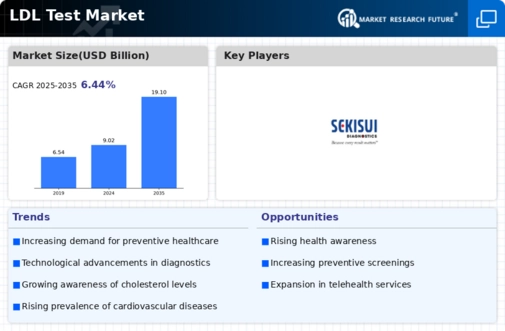Market Share
LDL Test Market Share Analysis
The LDL Test Market is a vital component of diagnostic testing, playing a crucial role in assessing cardiovascular health and managing conditions such as heart disease and stroke risk. In this competitive landscape, companies employ various market share positioning strategies to establish themselves and gain a competitive edge.
One prevalent strategy in the LDL Test Market is product differentiation. Companies differentiate their LDL testing products by offering unique features, such as assay sensitivity, specificity, turnaround time, and ease of use. For instance, some companies develop LDL test kits with advanced technology that enables rapid and accurate measurement of LDL cholesterol levels from a small sample volume. By highlighting these distinguishing features, companies aim to attract healthcare providers seeking innovative solutions that deliver reliable results and improve patient care.
Cost leadership is another effective strategy employed by companies in the LDL Test Market. Companies strive to become the low-cost providers of LDL testing products without compromising on quality or accuracy. By optimizing manufacturing processes, sourcing raw materials efficiently, and streamlining distribution channels, companies can offer competitive pricing, making their LDL test kits more accessible to healthcare facilities with budget constraints. Additionally, cost leadership strategies enable companies to penetrate price-sensitive segments of the market and gain market share by providing affordable alternatives to higher-priced competitors.
Market segmentation is also crucial for market share positioning in the LDL Test Market. Companies analyze the diverse needs and preferences of healthcare providers and patients to tailor their LDL testing products to specific market segments. For example, companies may develop specialized LDL test kits for different patient populations, such as pediatric, adult, or geriatric patients, addressing their unique testing requirements. By catering to specific segments, companies can effectively target niche markets and establish a strong presence, thereby increasing their market share.
Collaboration and partnerships play a significant role in market share positioning strategies within the LDL Test Market. Companies may collaborate with healthcare institutions, research organizations, or technology partners to enhance their product offerings, expand their market reach, or access new distribution channels. Strategic partnerships enable companies to leverage complementary expertise, resources, and networks, ultimately strengthening their competitive position in the market. For example, a company specializing in LDL testing products may partner with a leading clinical laboratory to validate the performance of their test kits and gain credibility in the market.
Continuous innovation is essential for maintaining and growing market share in the dynamic LDL Test Market. Companies invest in research and development to enhance the performance, accuracy, and usability of their LDL testing products. By staying abreast of technological advancements and addressing evolving customer needs, companies can differentiate their products, attract new customers, and retain existing ones. Innovation also enables companies to anticipate market trends, such as the increasing demand for point-of-care testing solutions or the integration of digital health technologies, and position their offerings accordingly to capture market share.












Leave a Comment